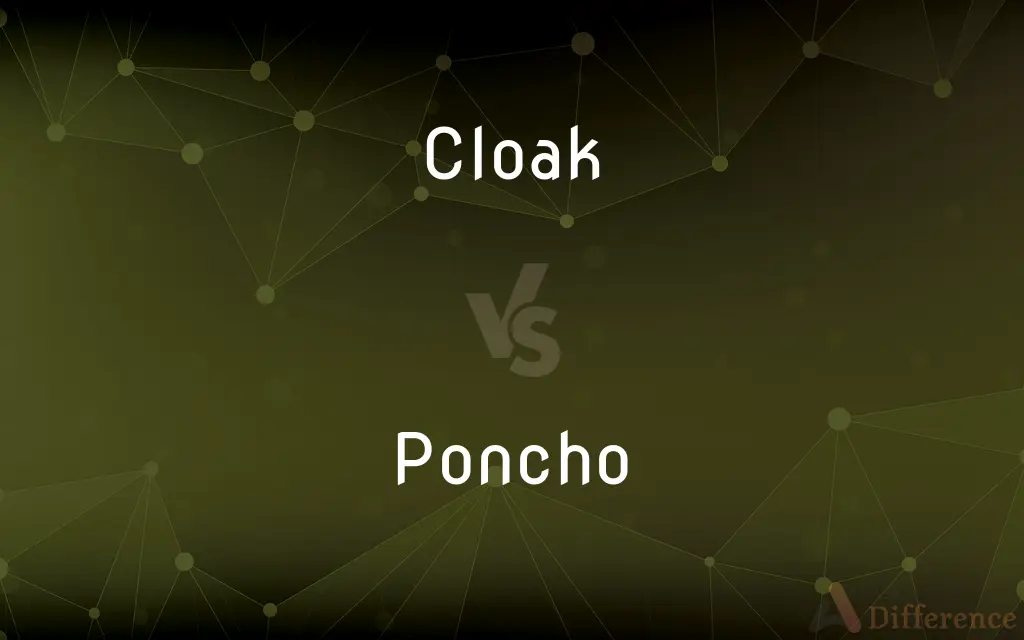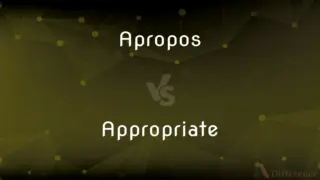Cloak vs. Poncho — What's the Difference?
Edited by Tayyaba Rehman — By Maham Liaqat — Updated on March 7, 2024
A garment worn over other clothes for warmth or protection, typically long and flowing. Poncho is a blanket-like outer garment with a hole for the head, offering simple, loose-fitting warmth.

Difference Between Cloak and Poncho
Table of Contents
ADVERTISEMENT
Key Differences
Cloaks are traditionally long, flowing garments that offer full-body coverage and are often associated with historical or fantasy attire, providing warmth and protection while adding a touch of elegance or mystique. They can come with or without a hood and are typically fastened at the neck. Ponchos, on the other hand, are simpler in design, originating from South American cultures. They are essentially a single large sheet of fabric with a hole in the center for the head, offering easy-to-wear warmth and protection from the elements. Ponchos are known for their convenience and versatility, often used in casual settings or as rain gear.
While cloaks often feature a fastening mechanism around the neck and may include intricate designs or decorations, emphasizing their role in fashion or ceremonial attire, ponchos are prized for their simplicity and functionality. The absence of sleeves or closures makes ponchos highly accessible and adaptable to various body types and activities. This difference in structure also influences the occasions for which each garment is suited; cloaks are frequently seen in more formal or thematic events, whereas ponchos are a go-to for casual outdoor activities or as practical rainwear.
The historical context and cultural significance of each garment also differ markedly. Cloaks have been worn throughout history in many parts of the world, evolving from practical garments into symbols of status and style. They are often seen in literature and film, representing characters from different eras or fantasy realms. Ponchos, however, have a strong cultural heritage tied to the indigenous peoples of the Andes in South America, reflecting a rich tradition of textile art and craftsmanship.
In terms of fashion versatility, cloaks offer a range of styles from dramatic and elegant to gothic or whimsical, often made from heavier materials like wool or velvet for added warmth. Ponchos present a more casual, bohemian vibe, crafted from a variety of materials including wool, cotton, and synthetic fibers, suitable for different weather conditions and personal preferences.
The practical aspects of wearing each garment reveal another layer of distinction. Cloaks, with their longer length and potential for a hood, provide extensive protection against cold weather and can be layered over multiple pieces of clothing. Ponchos, with their open sides and lack of sleeves, offer a more relaxed fit and easy layering, ideal for transitional weather or as a fashionable statement piece in milder climates.
ADVERTISEMENT
Comparison Chart
Design
Long, flowing, may have a hood, fastened at the neck
Single large sheet of fabric with a head hole, no fastenings
Origin & Cultural Significance
Historical, worn worldwide, symbol of status in some cultures
Indigenous to South America, especially the Andes, traditional
Functionality
Offers warmth and protection, more formal
Simple, versatile, used for warmth or rain protection
Material
Often made from heavier fabrics like wool or velvet
Can be made from various materials, including wool and cotton
Occasions
Formal events, thematic or historical reenactments
Casual wear, outdoor activities, rainwear
Compare with Definitions
Cloak
Fastened at the neck, varying in length and style.
Her elegant cloak was fastened with a brooch at the neckline.
Poncho
Versatile and used for casual or rainwear.
She packed a lightweight poncho for her hiking trip.
Cloak
May include a hood for added protection.
He pulled the hood of his cloak over his head to shield from the rain.
Poncho
Reflects a bohemian or casual style.
Her cotton poncho complemented the bohemian vibe of the festival.
Cloak
A long, flowing garment worn for warmth or protection.
She draped a velvet cloak over her shoulders for the chilly evening.
Poncho
Lacks sleeves or closures, fitting various body types.
The poncho's loose fit made it a favorite choice for outdoor concerts.
Cloak
Often associated with historical or ceremonial attire.
The knight donned his cloak before heading to the royal banquet.
Poncho
A blanket-like garment with a head hole, offering simple warmth.
He slipped a woolen poncho over his head to keep warm by the fire.
Cloak
Symbolic in literature and film.
The mysterious figure wrapped in a dark cloak vanished into the night.
Poncho
Originates from South American cultures.
The colorful poncho displayed traditional Andean patterns.
Cloak
A cloak is a type of loose garment that is worn over indoor clothing and serves the same purpose as an overcoat; it protects the wearer from the cold, rain or wind for example, or it may form part of a fashionable outfit or uniform. Cloaks have been used by myriad historic societies; many climates favor wearing a full-body garment which is easily removed and does not constrain the wearer with sleeves.
Poncho
A poncho (Spanish pronunciation: [ˈpontʃo]; Quechua: punchu; Mapudungun: pontro; "blanket", "woolen fabric") is an outer garment designed to keep the body warm. A rain poncho is made from a watertight material designed to keep the body dry from the rain.
Cloak
A sleeveless outdoor overgarment that hangs loosely from the shoulders
He threw his cloak about him
Poncho
A blanketlike cloak having a hole in the center for the head.
Cloak
A cloakroom
Ground-floor accommodation comprises hall, cloaks, lounge, kitchen
Poncho
A similar garment having a hood used as a raincoat.
Cloak
Dress in a cloak
They sat cloaked and hooded
Poncho
A simple garment, made from a rectangle of cloth, with a slit in the middle for the head.
Cloak
A long, loose outer garment, usually having a hood and no sleeves.
Poncho
A similar waterproof garment, today typically of rubber with a hood.
Cloak
Something that covers or conceals
A cloak of secrecy.
Poncho
A kind of cloak worn by the Spanish Americans, having the form of a blanket, with a slit in the middle for the head to pass through. A kind of poncho made of rubber or painted cloth is used by the mounted troops in the United States service.
Cloak
To cover or conceal with a cloak or something that acts like a cloak
Mist that cloaks the mountains.
Poncho
A trade name for camlets, or stout worsteds.
Cloak
A long outer garment worn over the shoulders covering the back; a cape, often with a hood.
Poncho
A blanket-like cloak with a hole in the center for the head
Cloak
A blanket-like covering, often metaphorical.
Night hid her movements with its cloak of darkness.
Cloak
(figurative) That which conceals; a disguise or pretext.
RQ:South Twelve Sermons
Cloak
(Internet) A text replacement for an IRC user's hostname or IP address, making the user less identifiable.
Cloak
(transitive) To cover as with a cloak.
Cloak
To cover up, hide or conceal.
Cloak
To render or become invisible via futuristic technology.
The ship cloaked before entering the enemy sector of space.
Cloak
A loose outer garment, extending from the neck downwards, and commonly without sleeves. It is longer than a cape, and is worn both by men and by women.
Cloak
That which conceals; a disguise or pretext; an excuse; a fair pretense; a mask; a cover.
No man is esteemed any ways considerable for policy who wears religion otherwise than as a cloak.
Cloak
To cover with, or as with, a cloak; hence, to hide or conceal.
Now glooming sadly, so to cloak her matter.
Cloak
Anything that covers or conceals
Cloak
A loose outer garment
Cloak
Hide under a false appearance;
He masked his disappointment
Common Curiosities
What is a cloak?
A cloak is a long, flowing garment worn over other clothes for warmth or protection, often featuring a hood and fastened at the neck.
What is a poncho?
A poncho is a simple, blanket-like garment with a hole for the head, offering loose-fitting warmth and protection from the elements.
Can cloaks and ponchos be made from the same materials?
Yes, both can be made from various materials including wool, cotton, and synthetic fibers, but cloaks often use heavier fabrics.
How do cloaks and ponchos differ in design?
Cloaks are long and may have a hood and fastenings, whereas ponchos are essentially a single large sheet of fabric without sleeves or closures.
Are ponchos culturally significant?
Yes, ponchos have a rich cultural heritage, especially among the indigenous peoples of the Andes in South America.
Is there a practical advantage to wearing a poncho?
Ponchos are known for their simplicity, ease of wear, and versatility, making them suitable for various body types and activities.
Can cloaks be considered fashionable?
Yes, cloaks can be very fashionable and are used in various styles, from elegant to gothic or whimsical.
Do both garments offer protection from the weather?
Yes, both offer warmth and can provide protection from rain or cold, but their design and coverage differ.
Can cloaks be part of a costume or thematic attire?
Yes, cloaks are often used in costumes, reenactments, or as part of thematic attire, reflecting their historical significance.
Are cloaks and ponchos suitable for the same occasions?
Generally, no. Cloaks are often worn at more formal or thematic events, while ponchos are more casual and practical for outdoor activities or rainwear.
Are there different styles of ponchos?
Yes, ponchos come in various styles, reflecting different cultures, materials, and uses, from casual to more traditional designs.
How do the origins of cloaks and ponchos differ?
Cloaks have been worn throughout history worldwide, while ponchos originate from South America and have a specific cultural significance.
Are cloaks used in modern fashion?
While not as common in everyday wear, cloaks are still used in fashion, especially in formal, thematic, or historical contexts.
What occasions are ponchos commonly worn?
Ponchos are commonly worn for casual outdoor activities, as rainwear, or as part of a bohemian fashion statement.
Is the length of a cloak significant?
Yes, the length of a cloak can vary, affecting its style, warmth, and the level of protection it provides.
Share Your Discovery

Previous Comparison
Apropos vs. Appropriate
Next Comparison
Riot vs. InsurrectionAuthor Spotlight
Written by
Maham LiaqatEdited by
Tayyaba RehmanTayyaba Rehman is a distinguished writer, currently serving as a primary contributor to askdifference.com. As a researcher in semantics and etymology, Tayyaba's passion for the complexity of languages and their distinctions has found a perfect home on the platform. Tayyaba delves into the intricacies of language, distinguishing between commonly confused words and phrases, thereby providing clarity for readers worldwide.
















































